![]()
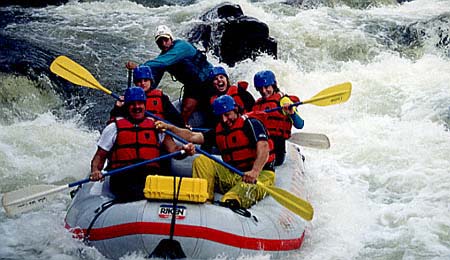
![]()
White water enthusiasts have been coming to the Ocoee River since 1976 for what is considered both a sport and world-wide recreation. Due to the circumstances, and being in the right place at the right time, an unused section of the Ocoee was ideal for Olympic racing. All that was needed to create the first natural river Olympic course was an ancient river bed, expert engineering, some strategically placed boulders and the power of rushing mountain water provided by nature and a TVA dam.
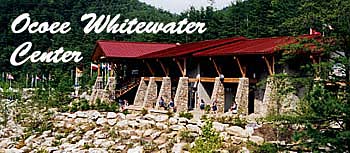 Left behind
from the 1996 Summer Olympics is the 7,600 sq ft. Ocoee White water Center.
It is now being used for public enjoyment and is operated by the U.S.
Forestry Service in Tennessee's Cherokee National Forest.
Left behind
from the 1996 Summer Olympics is the 7,600 sq ft. Ocoee White water Center.
It is now being used for public enjoyment and is operated by the U.S.
Forestry Service in Tennessee's Cherokee National Forest.
The center has large windows overlooking the river, and is designed in natural stones and timber beams. Inside you will find large color photos of the Olympic event, along with displays of historic photos of the region.
White water rapids in the Eastern U.S. are rated between 1-6. A #6 rated rapid is considered unsafe for commercial rafting. The upper Ocoee has three sets of #5 rapids over its five mile run, two of which are located within the newly constructed 1,700-ft. Olympic run. There are over 60,000 tons of boulders strategically placed to form a competitive racing channel 1,700-feet long, with river banks that were narrowed from 200-feet to a 70-100 foot width. Rather than leave the river bed dry as it had been in the past, the TVA and U.S. Forestry decided to make the upper Ocoee river available for periodic use, including 20 days of competitive events. For the first time ever, the upper Ocoee was opened to commercial rafting companies in September 1997.
Diehard spectators who enjoy white water watching along the middle Ocoee, have to look for minimal parking and usually have to work their way down large rocks and boulders to the river's bank, but it's worth the challenge.
Since the Olympics, river and pedestrian traffic has increased immensely and proper planning created ample room for everyone. Visitors have convenient parking and can stroll along sidewalks on both sides of the banks, near the Olympic Center or sit on boulders along the edge of the river to watch rafters, kayakers, and canoeists being thrown about by the current. The facilities make it perfect for family enjoyment.
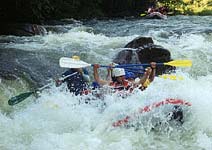 A road was built
along the north bank of the Ocoee in 1851 to accommodate the transportation
of copper from the mines in the upper valley of the "Copper Basin."
Most of the old road is gone, but a part of the road has been restored.
This road leads from the Olympic White water Center and runs east 2.4
miles along the banks of the Ocoee. About a half mile up the trail you'll
come to a set of #5-rated rapids called "Mickey's Ledge,"
a favorite spot for photographers and a great point of excitement for
rafters and river guides.
A road was built
along the north bank of the Ocoee in 1851 to accommodate the transportation
of copper from the mines in the upper valley of the "Copper Basin."
Most of the old road is gone, but a part of the road has been restored.
This road leads from the Olympic White water Center and runs east 2.4
miles along the banks of the Ocoee. About a half mile up the trail you'll
come to a set of #5-rated rapids called "Mickey's Ledge,"
a favorite spot for photographers and a great point of excitement for
rafters and river guides.
The opening of the upper Ocoee has brought a lot of excitement to the area. Rafters now have the opportunity to take on the Olympic course, an experience to write home about. Local rafting companies selected their most experienced guides to test the currents of this recently opened white water run. Kayakers and canoeists have descended upon these waters like a feeding frenzy of piranha, diving, spinning, powering into the rapids. They take on the mighty hydraulics, holding their own until ejected out and down the river.

Safety and teamwork are everything, from a rafting company and river-guide's point of view. Before leaving the rafting company's headquarters, safety instruction are given to group of rafters, then onto a bus and down to the river. Once they arrive at the river, each group meets with their rafting guide for last minute instructions.
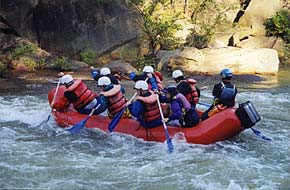 The Highlander
met with three year veteran and trip leader Tim Noland, for a technical
view of white water rafting. Tim told the Highlander, "it's essential
for groups to work and obey the safety rules, passengers can get hurt
and most turnovers result from lack of teamwork. Directions for safety
and fun rafting are simple. The commands for paddling are...all forward,
all back and drift. If the raft is caught in a 360 spin, the oar command
is either, right forward and left back or the opposite, depending on
the spin. Rafters must at all times grip the tee of the oar [top of
the oar handle], if not the white water or raft will drive the oar up,
usually hitting the paddler or another passenger in the upper body or
head.
The Highlander
met with three year veteran and trip leader Tim Noland, for a technical
view of white water rafting. Tim told the Highlander, "it's essential
for groups to work and obey the safety rules, passengers can get hurt
and most turnovers result from lack of teamwork. Directions for safety
and fun rafting are simple. The commands for paddling are...all forward,
all back and drift. If the raft is caught in a 360 spin, the oar command
is either, right forward and left back or the opposite, depending on
the spin. Rafters must at all times grip the tee of the oar [top of
the oar handle], if not the white water or raft will drive the oar up,
usually hitting the paddler or another passenger in the upper body or
head.
The best part of a white water trip is in the raft, so you'll want to stay in the raft. If you do get thrown out of the raft and into a hydraulic, ball up your body and the rapid will spit you out. If you're in less turbulent waters, lie back, straighten out your legs and flow with the river, this maneuver keeps your backside from hitting most rocks and keeps your legs from getting caught behind or between rocks. Proceed to ride the river, bareback until someone pulls you back into the raft. If the raft flips everyone, passengers should ride the river to a gentler stage and get out on the bank. The guide will gather up the group and find the raft...you're not done white watering yet."
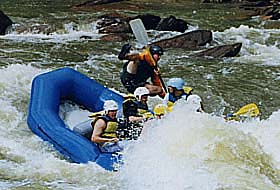
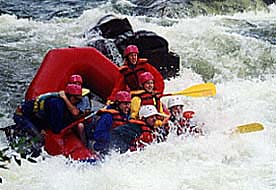
"White water rafting is a great recreational sport, it's exhilarating fun, and by the time your finished you're exhausted," says Tim Noland. "The passengers go home after experiencing the time of their life, while us river guides go back up the river and do it again and again, five days a week during the height of the season. It's such a physical sport, that it takes a toll on the guide's body when they do it year after year."
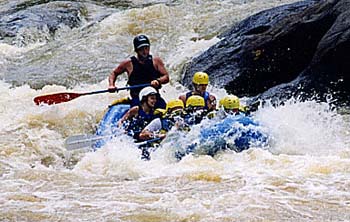 The upper Ocoee has brought
additional life to this mountain region and has added five more miles
of white water excitement. Rafters can choose to ride down the upper
Ocoee one day and the middle Ocoee the next day or pay a premium and
ride both sections in one trip. Most white water fans ride the waves
year after year. If you've never ridden the current and not sure you
want to, the Highlander suggests you pay a visit to the Ocoee White water
Center, bring a picnic, a camera and sit on the bank. It may only be
second best to actually rafting, but it's fun watching the rafters,
kayakers and canoeist make their way through difficult rapids. The rafters
are screaming and laughing, having a great time on the river and it's
contagious. Once you get your feet wet as you stand or sit along the
banks, you might find yourself making your way over to one of the rafting
companies, laying down your greenbacks and getting wet all over.
The upper Ocoee has brought
additional life to this mountain region and has added five more miles
of white water excitement. Rafters can choose to ride down the upper
Ocoee one day and the middle Ocoee the next day or pay a premium and
ride both sections in one trip. Most white water fans ride the waves
year after year. If you've never ridden the current and not sure you
want to, the Highlander suggests you pay a visit to the Ocoee White water
Center, bring a picnic, a camera and sit on the bank. It may only be
second best to actually rafting, but it's fun watching the rafters,
kayakers and canoeist make their way through difficult rapids. The rafters
are screaming and laughing, having a great time on the river and it's
contagious. Once you get your feet wet as you stand or sit along the
banks, you might find yourself making your way over to one of the rafting
companies, laying down your greenbacks and getting wet all over.
The Ocoee White water Center offers many events for additional fun, racing events, musical concerts, wildlife presentations and more. The Highlander was at the Center on September 27, 1997 and we had the unique opportunity to witness a wedding on the banks of the Olympic run, we were told, this was the second wedding since the opening of the Center.
Edwin Ditto III and his bride Alicia were taking the white water/white-wedding plunge. The bride was beautiful, the bridesmaid's were beautiful, the mothers of the betrothed were beautiful and the men in the wedding party well, how can I say it, they were a bunch of guys in monkey suits looking dapper and having a good time. Ditto is a kayaker on weekends and a Commodities Broker in Chattanooga, Tennessee during the week. The grooms father, Edwin Ditto II is a minister, he performed the services which brought a special touch to the sacred ceremony. Best wishes to the Dittos from the Blue Ridge Highlander.
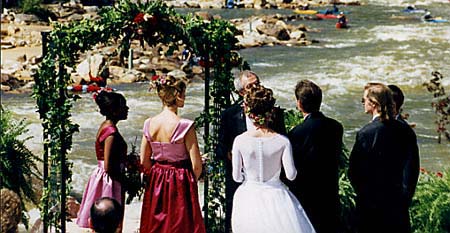
Back to the action...on the water, kayakers are spinning, turning and diving while canoeist are fighting, maneuvering and turning over. Meanwhile, rafters are making their way through the rapids, slamming into waves. In the mind's eye the kayakers and canoeist look as though they might be pirate vessels waiting to prey upon the helpless ships, as they move through dire straights.
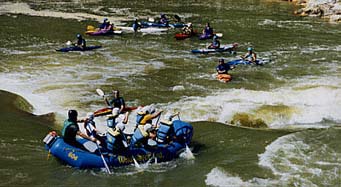
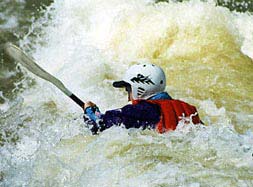
The truth is, the kayakers are waiting for the rafts to go by, and trying to avoid getting run over. Kayakers appear to be masochists who are obsessed with diving continuously into the under tow of white water.
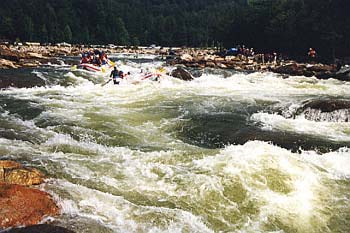
Moving down to the river's bank, the Highlander's sports photographer set up three cameras for the best views at Humongous, a #5-rated rapid. While we wait for rafters to come through, we observe and photograph kayakers within a 10 to 30 ft. distance. They plow into the surf like bronco riders, being pitched up, down, back and forth, completely submerging, then shooting the bow of the kayak straight up out of the water like a rocket, the ride ends as they're pitched down stream as another kayak enters the scene.
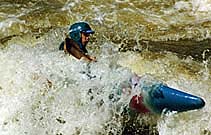
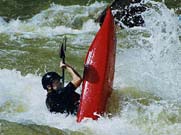
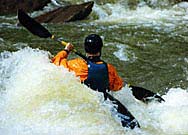
A canoe passes by, upside down, no canoeist in sight. A lone raft enters the scene,its bow dives into the rapid bending the raft at its center then rising into the air exposing its ominous under belly, rafters cheer and move on. Another raft enters the rapid, slams into the wall of water and turns sideways. The raft disappears into the hollow of two rapids, the novice crew works together as the guide directs them, they struggle to victory and cheer as they pass by. Another canoe goes by upside-down.
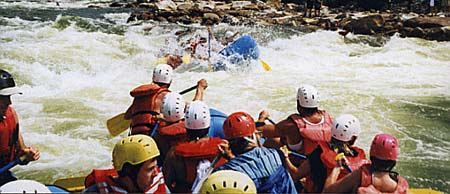
A raft containing
7 approaches Humongous, the bow rises out of the water like a killer
whale, then dives, the bow rises again and the current forces the raft
sideways, the raft then turns backwards attempting to 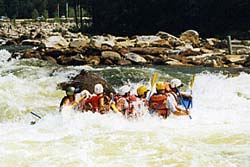 flee
on its own accord, the crew refuses to give up. The raft is caught on
its side, the crew is pitched to its starboard side, the raft flips
disengaging all its passengers. The crew, one by one tries to find their
way to the river's bank, the current is so strong that no gripping of
rocks will stop them, for now. An elderly man with only his head above
water tries to grip a rock to no avail.
flee
on its own accord, the crew refuses to give up. The raft is caught on
its side, the crew is pitched to its starboard side, the raft flips
disengaging all its passengers. The crew, one by one tries to find their
way to the river's bank, the current is so strong that no gripping of
rocks will stop them, for now. An elderly man with only his head above
water tries to grip a rock to no avail.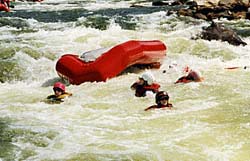 I stood with one foot
nearly in the water, his mature eyes met mine, he looked at me as though
I were his last hope. (Earlier, I saw a dry-lander reach out a hand
to a rafter in this strong current and got pulled in.) I looked into
his eyes, he stared into mine, I looked at the Nikon around my neck,
he stared right at me, I did the only thing I could...I wished him well.
About 20 minutes later I saw that entire group make their way back to
where their raft got pitched onto the shore about 25 feet from where
I was standing. I watched as the group climbed back into the raft and
headed out. I may have not have made a friend that day, but the one
thing I did learn was...that guy sure could body surf.
I stood with one foot
nearly in the water, his mature eyes met mine, he looked at me as though
I were his last hope. (Earlier, I saw a dry-lander reach out a hand
to a rafter in this strong current and got pulled in.) I looked into
his eyes, he stared into mine, I looked at the Nikon around my neck,
he stared right at me, I did the only thing I could...I wished him well.
About 20 minutes later I saw that entire group make their way back to
where their raft got pitched onto the shore about 25 feet from where
I was standing. I watched as the group climbed back into the raft and
headed out. I may have not have made a friend that day, but the one
thing I did learn was...that guy sure could body surf.
Keeping my eye on the action up stream through a pair of binoculars, I watched as groups of rafts made the turn and lined up for the run. The crew always looked excited with frozen smiles on their faces, the guides on the other hand had looks of concern, it was their job to get the crew through safely, rafting is a serious matter to them.
Raft after raft, picture after picture, I watched a passionate parade of human emotions.
There goes another upside down canoe, but wait, what do we see in the distance. Right oar, left oar, right oar, left oar, shoulders moving with precision like clock work. Suddenly, all those on the shore became witness to a canoeist walking a tight rope of white water, they cheered him on as he successfully passed before us.
Two more canoes went by...upside down.
Eighty percent of the rafts made it through without a hitch, twenty percent struggled through Humongous, some rafts flipped but no one appeared hurt. I asked my technical advisor Tim Noland how the guides liked the upper Ocoee, he said, "they enjoy it because it's new to them, it offers a challenge to the skills they acquired on the middle Ocoee."
Whether you're a rafter or spectator, both the upper and middle Ocoee River are exceptional white water runs. When you put in at the upper it's a gentle ride to the first set of rapids then the fun begins as you approach Mickey's Ledge.
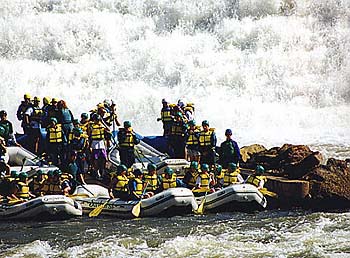 When you put
in at the middle Ocoee, rafters are faced with a twenty foot wall of
water rushing over a near prehistoric dam, pounding the rocks below
with a deafening sound...waters from hell. Here, there are two completely
different atmospheres that will change over a fifty foot distance. On
a busy day, rafters line up at the top of a concrete ramp that descends
down to the launch area. The crew and river guide lift their raft over
their heads and march slowly toward the rivers edge. No one seems to
speak during this part of the journey, it's a personal choice. The water
pouring over the dam is intimidating as well as loud, rafters contemplate
the worst, while fantasizing about the best. It's as though they were
about to cast off into uncertain waters on an attempted invasion of
a hostile water. Once the rafters reach the launch they place their
raft on the ground, standing in pairs, their upper body jokes, while
their knees knock. Over their shoulder and approximately 50 feet away
white water pours over Ocoee Dam #2, with a velocity of 2,000 cubic feet
per second. Now it's your turn to launch, everyone climbs in the raft,
followed by the river guide and you're off into a set of rapids called
"Grumpy's" a #4-rated rapid. "Grumpy's" is an immediate
introduction to extreme white water rafting. After your raft has cleared
this first set of rapids, the roar of laughter and cheers from the rafters
become so intense, they might need a team of paramedics to hand out
sedatives for the danger of too much excitement.
When you put
in at the middle Ocoee, rafters are faced with a twenty foot wall of
water rushing over a near prehistoric dam, pounding the rocks below
with a deafening sound...waters from hell. Here, there are two completely
different atmospheres that will change over a fifty foot distance. On
a busy day, rafters line up at the top of a concrete ramp that descends
down to the launch area. The crew and river guide lift their raft over
their heads and march slowly toward the rivers edge. No one seems to
speak during this part of the journey, it's a personal choice. The water
pouring over the dam is intimidating as well as loud, rafters contemplate
the worst, while fantasizing about the best. It's as though they were
about to cast off into uncertain waters on an attempted invasion of
a hostile water. Once the rafters reach the launch they place their
raft on the ground, standing in pairs, their upper body jokes, while
their knees knock. Over their shoulder and approximately 50 feet away
white water pours over Ocoee Dam #2, with a velocity of 2,000 cubic feet
per second. Now it's your turn to launch, everyone climbs in the raft,
followed by the river guide and you're off into a set of rapids called
"Grumpy's" a #4-rated rapid. "Grumpy's" is an immediate
introduction to extreme white water rafting. After your raft has cleared
this first set of rapids, the roar of laughter and cheers from the rafters
become so intense, they might need a team of paramedics to hand out
sedatives for the danger of too much excitement.
White water rafting has become so popular that in 1996, 175,000 visitors rode the Ocoee, this year an estimated 250,000 felt the excitement of this remote Tennessee river. With rapid names like, Grumpy's, Mickey's Ledge, Double Trouble, Double Suck, Humongous, Hell's Hole, Broken Nose, Slice and Dice, Sling Shot and Washing Machine you know you're in for a good time.
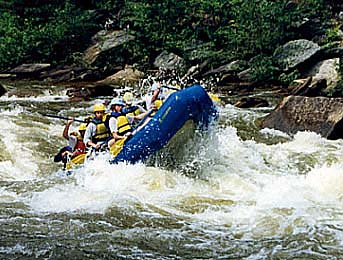
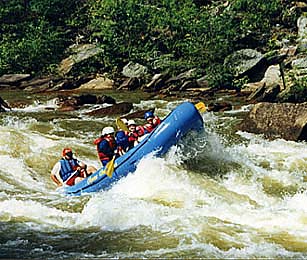
The Ocoee River is an outstanding recreation area. Thanks to the co-operation of the TVA, the U.S. Forestry Service and 22 rafting companies the river has returned to the people. The Ocoee Gorge is a marvel of nature, each season creates a dramatic new look. The river runs through the narrow walls of the gorge while a two lane paved road winds along the river's edge.
A friend of the Blue Ridge Highlander, Frank DeBartolo has affectionately described the river gorge in this way. "When I begin the ascent through the gorge, I am first over-taken by the grandeur of its beauty. I drive along the steep walls and river's edge with great anticipation until I reach Boyd Gap. Suddenly, I behold the beauty of the mountain vista, it's at this point that I realize, I've come home."
The rafters are excited about the opening of the upper Ocoee, visitors get a extra thrill knowing they're rafting through the Olympic course. This renewing of the old riverbed has brought additional life to the ever-growing popularity of Ocoee's white water rafting."
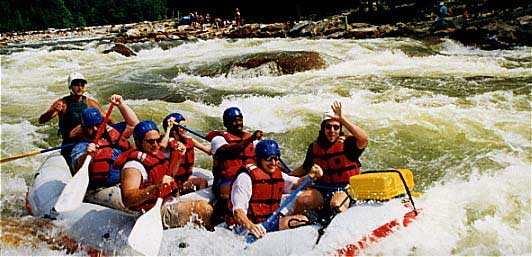
White water rafting, kayaking and canoeing is not a fad but a growing water recreation with a long history. It's an exciting experience you'll never forget, but beware you might just get hooked and you'll definitely get wet but that's part of the fun.
Click Here to read White water in the Morning! the Ole Blue Swimmin Hole....
Click here to read about the History of the Ocoee...
![]()
Sign
up for the Blue Ridge Highlander Newsletter, Messages from the Mountains
to find out first about our new feature stories, road trips and special offers
Your e-mail addresses will not be sold or given away to anyone.
Privacy
Policy
Interested in your business being on the Highlander, click here...
Let our visitors tell you about the Highlander...
Click the feathers to go to the Highlander site
map...

